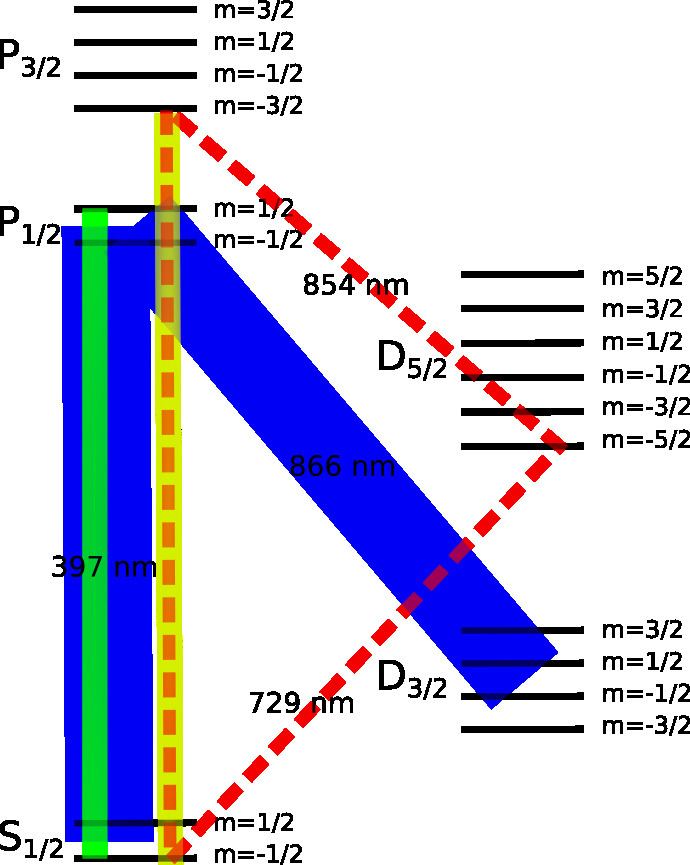 | ||
Resolved sideband cooling is a laser cooling technique allowing cooling of tightly bound atoms and ions beyond the Doppler cooling limit, potentially to their motional ground state. Aside from the curiosity of having a particle at zero point energy, such preparation of a particle in a definite state with high probability (initialization) is an essential part of state manipulation experiments in quantum optics and quantum computing.
Contents
Conceptual description
Resolved sideband cooling is a laser cooling technique that can be used to cool strongly trapped atoms to the quantum ground state of their motion. The atoms are usually precooled using the Doppler laser cooling. Subsequently, the resolved sideband cooling is used to cool the atoms beyond the Doppler cooling limit.
A cold trapped atom can be treated to a good approximation as a quantum mechanical harmonic oscillator. If the spontaneous decay rate is much smaller than the vibrational frequency of the atom in the trap, the energy levels of the system can be resolved as consisting of internal levels each corresponding to a ladder of vibrational states.
Suppose a two-level atom whose ground state is shown by g and excited state by e. Efficient laser cooling occurs when the frequency of the laser beam is tuned to the red sideband i.e.
where
where
Subsequent spontaneous emission occurs predominantly at the carrier frequency if the recoil energy of the atom is negligible compared with the vibrational quantum energy i.e.
This process is labeled '2' in the adjacent image. The average effect of this mechanism is cooling the ion by one vibrational energy level. When these steps are repeated a sufficient number of times
Theoretical basis
The core process that provides the cooling assumes a two level system that is well localized compared to the wavelength (
with
and where
That is, incidentally, the Jaynes-Cummings Hamiltonian used to describe the phenomenon of an atom coupled to a cavity in cavity QED. The absorption(emission) of photons by the atom is then governed by the off-diagonal elements, with probability of a transition between vibrational states
If the
Experimental implementations
For resolved sideband cooling to be effective, the process needs to start at sufficiently low
ions and the Raman sideband cooling of Cs atoms.
Example: cooling of Ca+ ions
The energy levels relevant to the cooling scheme for Ca+
ions are the S1/2, P1/2, P3/2, D3/2, and D5/2, which are additionally split by a static magnetic field to their Zeeman manifolds. Doppler cooling is applied on the dipole S1/2 - P1/2 transition (397 nm), however, there is about 6% probability of spontaneous decay to the long-lived D3/2 state, so that state is simultaneously pumped out (at 866 nm) to improve Doppler cooling. Sideband cooling is performed on the narrow quadrupole transition S1/2 - D5/2 (729 nm), however, the long-lived D5/2 state needs to be pumped out to the short lived P3/2 state (at 854 nm) to recycle the ion to the ground S1/2 state and maintain cooling performance. One possible implementation was carried out by Leibfried et al. and a similar one is detailed by Roos. For each data point in the 729 nm absorption spectrum, a few hundred iterations of the following are executed:
Variations of this scheme relaxing the requirements or improving the results are being investigated/used by several ion-trapping groups.
Example: Raman sideband cooling of Cs atoms
A Raman transition replaces the one-photon transition used in the sideband above by a two-photon process via a virtual level. In the Cs cooling experiment carried out by Hamann et al., trapping is provided by an isotropic optical lattice in a magnetic field, which also provides Raman coupling to the red sideband of the Zeeman manifolds. The process followed in is:
